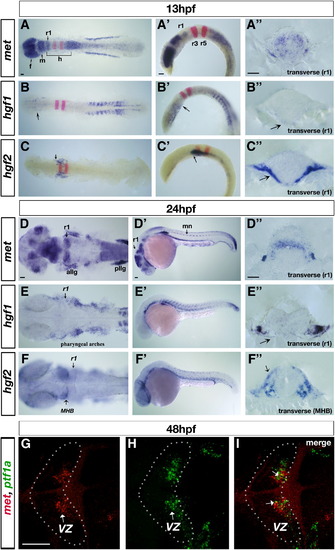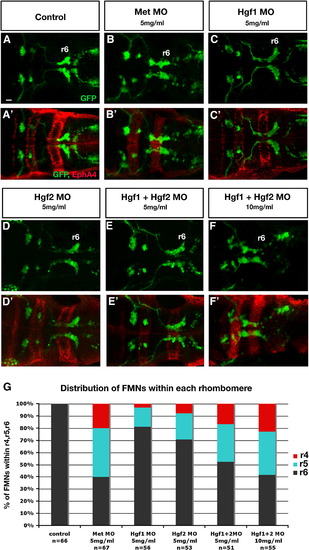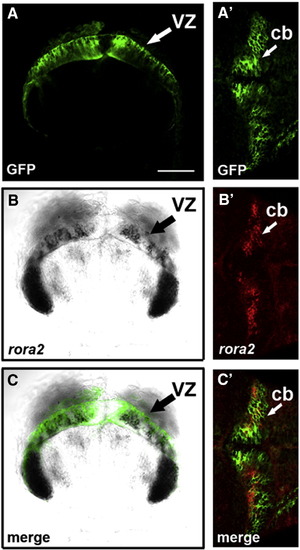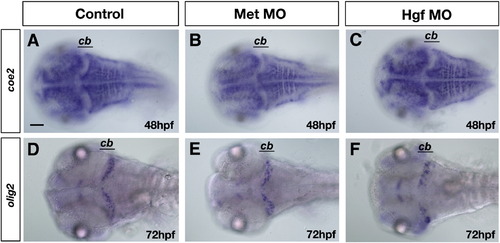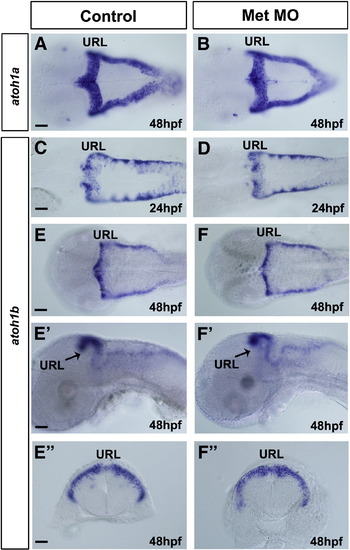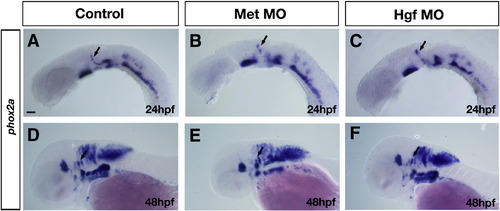- Title
-
The autism susceptibility gene met regulates zebrafish cerebellar development and facial motor neuron migration
- Authors
- Elsen, G.E., Choi, L.Y., Prince, V.E., and Ho, R.K.
- Source
- Full text @ Dev. Biol.
|
Zebrafish met receptor and hgf1 and hgf2 ligand expression patterns in the nervous system. (A–F) in situ hybridization revealing expression of met receptor (A–A″ and D–D″), hgf1 ligand (B–B″ and E–E″) and hgf2 ligand (C–C″ and F–F″) at 13 hpf (A–C″) and 24 hpf (D–F″) in dorsal (A–F), lateral (A′–F′) and transverse views (A″–F″). krox20 expression (red in A–C′) marks rhombomere (r) 3 and r5. At 13 hpf, met (A–A″) is expressed at high levels in the forebrain, dorsal midbrain, a stripe in r1 and in a gradient starting in r7 that tapers off towards the posterior part of the spinal cord. met is also present at low levels throughout the hindbrain. At 24 hpf, met (D–D″) continues to be expressed in the forebrain regions, eyes, dorsal midbrain, dorsal r1 and in a gradient from r7 towards the posterior, as well as in the anterior and posterior lateral line ganglia, and motor neurons of the spinal cord. At 13 hpf, hgf1 (B–B″) is expressed in the ventral regions of the forebrain (arrow in B), and at low levels throughout the hindbrain, in ventral regions surrounding r1 (arrow in B′ and B″), while hgf2 (C–C″) is expressed in low levels in the hindbrain and in ventral regions surrounding the hindbrain (arrow in C, C′ and C″), including r1. At 24 hpf, hgf1 (E–E″) is expressed at low levels throughout the hindbrain, in ventral tissues surrounding r1 and in pharyngeal arches, while hgf2 (F–F″) is expressed in the dorsal eye, ventral tissues surrounding the hindbrain and in tissues surrounding the MHB (arrow in F and F″). (G–I) Confocal images of double fluorescent in situ hybridization with met (G) and ptf1a (H) in dorsal view, anterior to the left, at 48 hpf, showing colocalization of the two transcripts in a small number of cells (arrows in I, merged) in the VZ (arrows in G and H) of the cerebellum (outlined in G–I). r5, rhombomere5; r1, rhombomere1; r7, rhombomere7; allg, anterior lateral line ganglia; pllg, posterior lateral line ganglia; mn, motor neurons; MHB, midbrain–hindbrain boundary; VZ, ventricular zone. Scale bar, 50 μm. EXPRESSION / LABELING:
|
|
Abnormal cerebellar morphology and reduction of differentiated neurons in Met signaling morphants. (A–C) Lateral bright-field view of 48 hpf embryos illustrating the orientation of horizontal confocal sections shown in panels (D)–(I′) (d, dorsal) and (mv, mid-ventral) in (A) control, (B) Met morphants and (C) Hgf double morphants (Hgf1 + 2 MO). Anterior is to the left in all panels and dorsal up in (A)–(C). (D–I′) Horizontal confocal sections, dorsal view, through the midbrain and hindbrain in live 48 hpf HuC-GFP-positive embryos imaged in dorsal positions (D–F′) and mid-ventral positions (G–I′) in controls (D, D′, G and G′), Met morphants (E, E′, H and H′) and Hgf1 + 2 double morphants (F, F′, I and I′). Bright-field and fluorescence images were merged to show the presence of Hu-positive cells away from the proliferative zone (D′, E′, F′, G′, H′ and I′). The number of HuC-positive newly differentiated neurons is reduced in Met morphants (E and H) and Hgf double morphants (F and I) compared to controls (D and G). Cerebellar regions are indicated by white brackets (D–I), and dorsal cerebellar midline fusion is highlighted by a black line indicating the degree of morphological change (D′–I′) in Met morphants (E′ and H′) and Hgf double morphants (F′ and I′) compared to controls (D′ and G′). cb, cerebellum. Scale bar, 50 μm. PHENOTYPE:
|
|
Altered expression of ventricular zone derivative markers in Met signaling morphants. Dorsal (A–C and G–L) and transverse views (D–F′ and M–O′) taken at the level of the cerebellum of control (A, D, D′, G, J, M and M′), Met morphants (B, E, E′, H, K, N and N′) and Hgf morphants (C, F, F′, I, L, O and O′) at 48 hpf (A–F′) and 72 hpf (G–O′) showing expression of ventricular zone (VZ) progenitor marker ptf1a (A–I), and of Purkinje cell marker rora2 (J–O′) in the cerebellum. At 48 hpf, ptf1a expression in the dorsal midline region of the cerebellum is missing in Met morphants (arrows in B, E and E′) and in Hgf morphants (arrows in C, F and F′) compared to controls (arrows in A, D and D′). Similarly, at 72 hpf, ptf1a expression in the dorsal midline region of the cerebellum continues to be absent in Met morphants (arrow in H) and Hgf morphants (arrow in I) compared to controls (arrow in G). In addition, at 72 hpf, expression levels of ptf1a in the rest of the cerebellum is down-regulated in Met and Hgf morphants (H and I) compared to controls (G). Neuroepithelium is outlined with a broken line in (D)–(F′). The boxed region in D–F is shown at higher magnification in (D′)–(F′). At 72 hpf, the expression of Purkinje cell marker rora2 in the entire cerebellum, including the dorsal midline region of Met morphants (K, N and N′) and Hgf morphants (L, O and O′) is significantly reduced compared to the expression in the cerebellum of control embryos (J, M and M′). The boxed region in M–O is shown at higher magnification in M′–O′. morphants, MO (morpholino) injected embryos; cb, cerebellum. Scale bar, 50 μm. EXPRESSION / LABELING:
PHENOTYPE:
|
|
Altered expression of upper rhombic lip derivative markers in Met signaling morphants. Dorsal (A–F and J–L) and transverse views taken at the level of the cerebellum (D′–F′ and G′–I′) of control (A, D, D′, G and G′), Met morphants (B, E, E′, H and H′) and Hgf double morphants (C, F, F′, I and I′) at 24 hpf (A–C) and 72 hpf (D–I′) showing expression of atoh1a (A–C), pax6a (D–F′) and reelin (G–I′) in the cerebellum (cb), marked with brackets. The expression of atoh1a in the granule cell progenitors in the URL is not affected in Met morphants (B) and Hgf morphants (C) compared to controls (A). In contrast, the expression of markers of differentiated granule cells, pax6a (D–F′) and reelin (G–I′), is severely disrupted in Met morphants (E and E′ and H and H′, respectively) and Hgf morphants (F and F′ and I and I′, respectively) compared to controls (D and D′ and G and G′, respectively). Arrows in control embryos indicate the expression in cerebellar region (D), including expression in dorsal and ventrolateral domains in transverse sections (D′ and G′). In contrast, arrows in the Met morphants and Hgf morphants point to the absence of granule cell marker expression in both dorsal regions and in ventrolateral regions in dorsal (E and F, respectively) and transverse sections (E′ and H′ and F′ and I′, respectively). The regions of the midline at the level of the 4th ventricle and the two lateral stripes of radial glia are pax6a-positive (D′–F′) and reelin-positive (G′–I′) at 72 hpf and are not affected in Met signaling morphants (E′, F′, H′ and I′) compared to control embryos (D′ and G′). URL, upper rhombic lip; cb, cerebellum. Scale bar, 50 μm. EXPRESSION / LABELING:
PHENOTYPE:
|
|
Met signaling is required for cerebellar proliferation. (A–C) Dorsal longitudinal confocal images (z-projections at maximum intensity) and (E–G′) single dorsal longitudinal confocal sections of posterior midbrain and anterior hindbrain of 24 hpf embryos of control (A, E and E′), Met morphants (B, F and F′) and Hgf double morphants (C, G and G′) illustrating total proliferation in the cerebellum (A–C), cerebellar proliferation within a confocal section marked by anti-PH3 antibody in red (E–G) and cerebellar nuclei within a confocal section counterstained with Sytox Green (E′–G′). Compared to controls (A), Met and Hgf double morphants (B and C) showed reduced total mitotic cells in cerebellar (cb) regions marked by brackets and outlined by the broken line. The graph (D) represents the quantitative analysis of total cerebellar proliferative cells, showing a highly significant decrease in global proliferation in the morphants compared to controls. The graph (H) represents the quantitative analysis of the mitotic index (mitotic cells/total cells) in the cerebellum showing a significant decrease in the mitotic index of morphants compared to controls. Bars represent the combined results of two independent experiments. n, the number of embryos assessed per experimental condition; asterisks in panels (D) and (H) indicate significant statistical difference compared to controls. Scale bar, 50 μm. PHENOTYPE:
|
|
Expression of met receptor and hgf1 and hgf2 ligand in the facial motor neurons (FMNs). (A–C) Dorsal view and (A′–C′) transverse views at the level of r5 in the hindbrain of 33 hpf embryos showing mRNA expression of met receptor (A and A′), hgf1 ligand (B and B′) and hgf2 ligand (C and C′). met receptor is expressed in the migratory FMNs (arrows in A and A′) in the ventral hindbrain, while hgf1 and hgf2 ligands are expressed in ventral tissues surrounding the hindbrain in regions where FMNs migrate towards the posterior hindbrain (arrows in B′ and C′, respectively). In addition, hgf1 and hgf2 ligands are expressed in pharyngeal arches, ventrolateral to the hindbrain (arrows in B and B′ and C and C′, respectively). White lines in (A)–(C) indicate the position at which transverse sections were obtained (A′–C′). (D–F) Dorsal confocal sections of 48 hpf Islet1-GFP embryos in the hindbrain regions showing colocalization (in F) of met mRNA (E) with GFP antibody in green (D) in the VII nerve and in the X nerve. White arrows in (F) indicate the presence of met transcripts in other population of hindbrain cells. (G–I) Dorsal confocal sections of 48 hpf Isl1-GFP embryos in the hindbrain regions double stained with GFP antibody in green (G) and Zn5 antibody, which recognizes zebrafish DM-GRASP, a cell adhesion molecule, in red (H) in the abducens motor neurons (VI nerve). Colocalization of GFP and Zn5 antibodies (in I) identifies the population of met-positive neurons as the abducens motor neurons; neurons also indicated by white arrows in (F) and (I). FMNs, facial motor neurons; V, trigeminal motor neurons of the V nerve; VII, facial motor neurons of the VII nerve; X, vagal motor neurons of the X nerve; VI, abducens motor neurons of the VI nerve. Scale bar, 50 μm. |
|
Met signaling is required for FMN migration. The disposition of FMNs is visualized using 48 hpf Islet1-GFP (Isl1-GFP) transgenic embryos (A–F) double labeled with GFP antibody in green (A–F) to detect branchiomotor neurons and EphA4 antibody in red (A′–F′) as a landmark of r3 and r5 to identify the position of FMNs at 48 hpf. (A–F) Dorsal confocal fluorescence images of the hindbrain in dorsal view (A–F); anterior is to the left. r6 (the final destination of all FMNs at 48 hpf) is labeled in all panels (A–F). In control embryos (A and A′), all FMNs have completed their migration and settled in r6. In contrast, in Met morphants (B and B′, Met MO, 5 mg/ml), the majority of FMNs did not complete their migration to r6 and remain in r4 and r5. In Hgf1 morphants (C and C′, Hgf1 MO, 5 mg/ml), only a few FMNs did not complete their migration, while the majority reached r6. Similarly, in Hgf2 morphants (D and D′, Hgf2 MO, 5 mg/ml), some neurons completed their migration to r6, while others failed to exit r4 and r5. Simultaneous microinjection of Hgf1 and Hgf2 MO (E and E′, each at 2.5 mg/ml) led to a higher percentage of FMNs that failed to complete their migration to r6 than when each Hgf MO was microinjected alone at 5 mg/ml (B and B′ and C and C′). In addition, microinjection of Hgf1 and Hgf2 MO (F and F′, each at 5 mg/ml) led to a more drastic migration phenotype with the majority of the FMNs failing to exit r4 and r5, a phenotype that closely resembles that observed in Met morphants (B and B′). The graph in G shows the percentage distribution of FMNs within r4, r5 and r6 for each of the conditions mentioned in (A)–(F). Scale bar, 50 μm. PHENOTYPE:
|
|
Expression of the met receptor gene in medial rhombomere 1 (presumptive cerebellum). Lateral view (A and B) and transverse sections (A′, A″, B′ and C) at the level of the midbrain (A′) and cerebellum (A″, B′ and C) of in situ hybridization of 24 hpf embryos showing expression of the met receptor gene in purple (A, A′, A″, B and B′), atoh1a (red in B and purple in B′) and atoh1b (purple in C). In the midbrain region, met expression is abundant in the dorsal domain (A and A′), while in r1, expression is confined to the medial domain (A and A″) corresponding to the ventricular zone of the cerebellum. Double in situ hybridization (B) with met and atoh1a probes shows complementary expression within the cerebellar region, with met being expressed medially in the ventricular zone region and atoh1a being expressed dorsally in the upper rhombic lip region. Single in situ hybridizations with met (A″), atoh1a (B′) and atoh1b (C) also show the complementary expression domains of the met and atoh1 genes. Anterior is to the left and dorsal (transverse sections) is up in all Supplementary figures. mb, midbrain; cb, cerebellum; VZ, ventricular zone; URL, upper rhombic lip. Scale bar, 50 μm. |
|
Expression of rora2 gene in the GFP-positive cells derived from the VZ of ptf1a-GFP transgenic fish. Transverse confocal sections (A) and bright-field (B) and dorsal confocal sections (A′ and B′) in 72 hpf embryos showing GFP antibody staining of GFP-positive VZ-derived cells from ptf1a-GFP transgenic fish (A), and in situ hybridization with rora2 probe (B), and merged (C). rora2 transcript is expressed in the GFP-positive cells derived from the ptf1a-positive VZ zone cells (C and C′). Scale bar, 50 μm. |
|
Met signaling regulates a subpopulation of VZ-derived cells. Dorsal view (A–F) of control embryos (A and D), Met morphants (B and E) and Hgf morphants (C and F) at 48 hpf (A–C), and 72 hpf (D–F) embryos showing expression of coe2 (A–C) and olig2 (D–F) in the VZ-derived cells of the cerebellum (cb). coe2 expression is down-regulated in morphants compared to controls, while olig2 expression is unchanged. Scale bar, 50 μm. |
|
Expression of URL markers (atoh1a and atoh1b) is unaltered in Met signaling morphants. Dorsal view (A–F), lateral view (E′ and F′) and transverse view at the level of the URL (E″ and F″) in 24 hpf embryos (C and D) and 48 hpf embryos (A, B and E–F″) showing in situ hybridization of atoh1a (A and B) and atoh1b (C–F″) in control embryos (A, C, E, E′ and E″) and Met morphants (B, D, F, F′ and F″). There is no significant change in expression of atoh1a and atoh1b in Met morphants compared to control embryos. Scale bar, 50 μm. |
|
Neurons derived from URL are unaltered in Met signaling morphants. Lateral view (A–F) of phox2a expression in the locus coeruleus neurons (indicated by arrows) in control (A and D), Met morphants (B and E) and Hgf morphants (C and F) of 24 hpf (A–C) and 48 hpf (D–F) embryos. phox2a expression in neurons derived from the URL is unchanged in morphants compared to controls at 24 hpf, but there is a slight delay in the dorsal to ventral migration of these neurons. At 48 hpf, these neurons have completed their migration to the ventral hindbrain region in both controls and morphants. Scale bar, 50 μm. |
|
Met signaling plays a role in neuronal survival. Dorsal view (A–C) of control (A), Met morphants (B) and Hgf morphants (C) at 24 hpf showing acridine orange staining in live embryos to detect cell death. Anterior to the left. There is an increase in cell death in both Met and Hgf morphants, not only in the cerebellar region but also throughout the rest of the hindbrain (indicated in brackets) and other CNS regions. Scale bar, 50 μm. |

Unillustrated author statements EXPRESSION / LABELING:
|
Reprinted from Developmental Biology, 335(1), Elsen, G.E., Choi, L.Y., Prince, V.E., and Ho, R.K., The autism susceptibility gene met regulates zebrafish cerebellar development and facial motor neuron migration, 78-92, Copyright (2009) with permission from Elsevier. Full text @ Dev. Biol.

